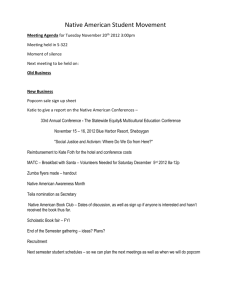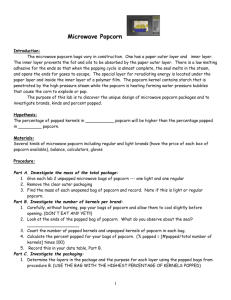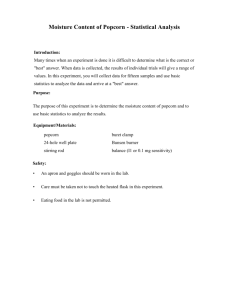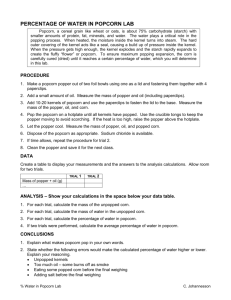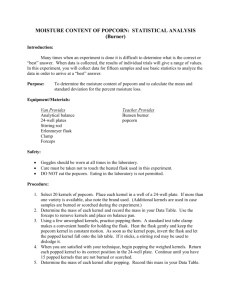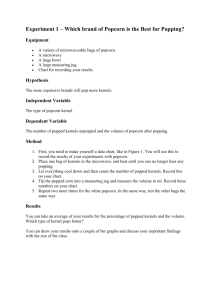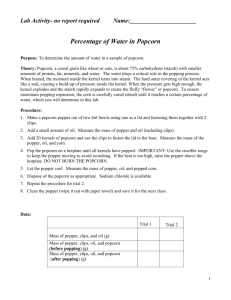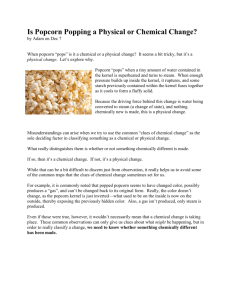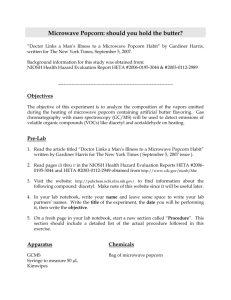Microwave Popcorn - Biology Junction
advertisement
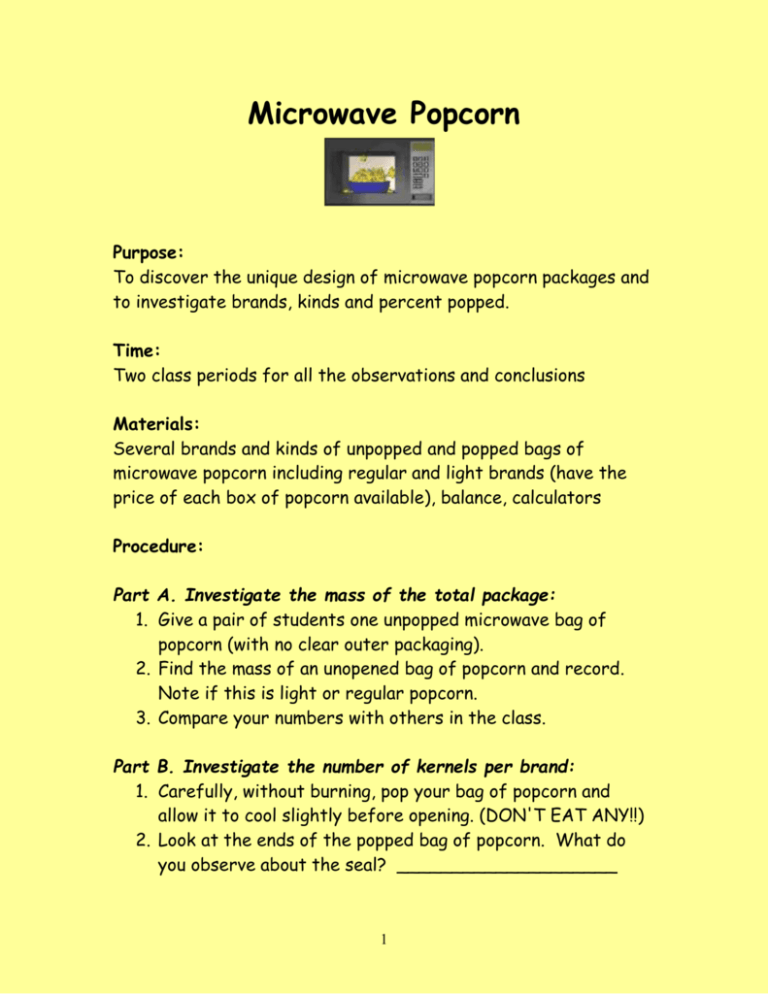
Microwave Popcorn Purpose: To discover the unique design of microwave popcorn packages and to investigate brands, kinds and percent popped. Time: Two class periods for all the observations and conclusions Materials: Several brands and kinds of unpopped and popped bags of microwave popcorn including regular and light brands (have the price of each box of popcorn available), balance, calculators Procedure: Part A. Investigate the mass of the total package: 1. Give a pair of students one unpopped microwave bag of popcorn (with no clear outer packaging). 2. Find the mass of an unopened bag of popcorn and record. Note if this is light or regular popcorn. 3. Compare your numbers with others in the class. Part B. Investigate the number of kernels per brand: 1. Carefully, without burning, pop your bag of popcorn and allow it to cool slightly before opening. (DON'T EAT ANY!!) 2. Look at the ends of the popped bag of popcorn. What do you observe about the seal? ____________________ 1 3. Count the number of popped kernels and unpopped kernels of popcorn in a bag. 4. Calculate the percent popped for your brand and kind of popcorn. (% popped = [#popped/total number of kernels] times 100) 5. Prepare a data table for this information. Put your data with the class data for all to see. Part C. Investigate the packaging: 1. Determine the layers in the package and the purpose for each layer using the popped bag from procedure B. 2. Find the special layer that can absorb microwave energy and reradiate it as infrared energy to increase the temperature inside the bag? Where is this layer located in relation to the position of the bag in the oven? 3. Sketch a cross section of the layers in the bag. What is the shape of the absorbing layer (rectangle, triangle, or circle)? Data: Part A Brand of popcorn Light or regular Our Group 2 Mass of Unpopped bag Part B # of Unpopped kernels # of Popped kernels Percent Popped Our Group Part C Number of layers __________ Location of "popping" layer __________________________ Sketch of cross section of bag layers: Shape of Absorbing layer _________________ 3 Conclusions: 1. Compare the masses of packages of unpopped popcorn. Is there a difference between regular and light? Is there a difference between brands? 2. How did the seals on the ends of the popped bag look before you opened the bag? 3. Do all brands of microwave popcorn have the same number of kernels? Which brand had the most? Least? 4. Which brand had the most percent popped? Least? 5. Calculate the cost per bag and the cost per kernel for each brand. 6. Compare your sketch in Part C with others. Is the layer for absorbing microwaves in the same position in all brands? Is it the same shape/size? 7. How does this absorbing layer differ from the outside layer of the package? 8. Explain how popcorn pops. What is the white fluffy stuff? 4 Teacher Notes on Microwave Popcorn: This activity has students design their own data tables and encourages them to take notes. If a class needs more direction, provide them with tables to fill-in as students progress through the procedure. The microwave popcorn bags vary in construction. One has a paper outer layer with a PET (same polymer that is found in the two-liter bottle) inner layer. The PET layer prevents the fat and oils to be absorbed by the paper outer layer. Paper is very inexpensive. There is a low melting adhesive for the ends so that when the popping cycle is almost complete, the seal melts in the steam, and opens the ends for gases to escape. The special layer for reradiating energy is located under the paper layer and inside the inner layer of a polymer film. This layer is called the susceptor and it is a metallized PET film. Aluminum is sprayed onto the film in a vacuum chamber to prepare this metallized film. All producers of these packages now use a susceptor in one geometric shape or another. They do not have to cover the entire package. The susceptor is placed on the bottom of the microwave oven with the corn resting on top. Other packages might use OPP (oriented polypropylene) for an over-wrap which costs less than PET. The package is still evolving since manufacturers are striving to minimize unpopped kernels. Popcorn contains mostly the translucent endosperm as opposed to the opaque endosperm. This endosperm is penetrated by the high pressure steam while the popcorn is heating. The starch granules change into gelatinized globules and then expand into thin fusible bubbles as the pericarp is burst by the pressure of the water vapor. The pericarp is the protective layer on the outside of the kernel. It breaks at about a pressure of 9 atmospheres. 5 The three kinds of popcorn (in the table) had rectangularshaped susceptors. Orville Redenbacher popcorn had an average of 94% popped (for 3 minutes on high) with about 460 kernels per bag. Adapted from Missouri Polymer Ambassador 6
